Long before the beginning of our era, people knew such a plant as asparagus. Growing it, for example, in Ancient Egypt was a matter of both healers, who knew the healing properties of these green shoots, and peasants, who appreciated their delicate taste.
The ancient Greeks preferred this plant not only for its beneficial properties, but also for its beauty during the ripening period - wreaths were made of newlyweds from them.
Today, asparagus is consumed by those who really monitor their health and know the value of its nutrients.
Beneficial features
Unfortunately, in some countries today Asparagus officinalis is either undeservedly forgotten, or people responsible for agricultural planning prefer crops that are economically more profitable.
This vegetable plant grows in almost all countries of the world, except for the northern regions, and still in the meadows you can meet its wild "relatives". People in antiquity did not know what kind of useful substances asparagus possesses, the cultivation and distribution of which continued until the Middle Ages. It was actively used in the form of decoctions.
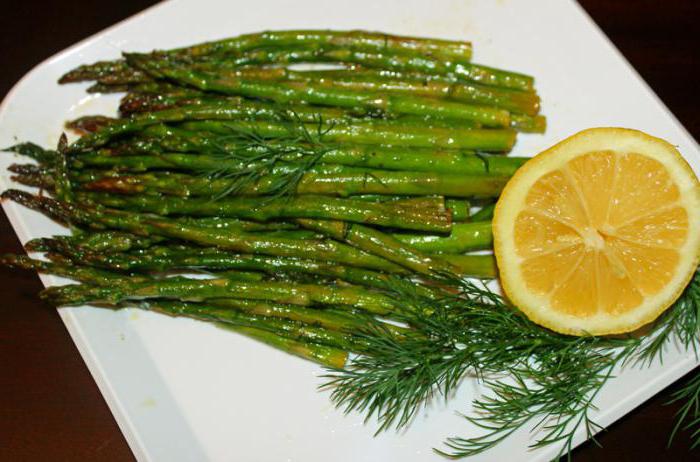
This would continue even if the churchmen did not recognize her as a sinful escape, having the properties of an aphrodisiac. This fact for a while removed a useful vegetable from the diet of people.
Today, scientists are well aware of the chemical composition of this plant, which includes:
- asparagine, normalizing blood pressure, the work of the kidneys and the cardiovascular system;
- folic acid, especially necessary for women during pregnancy;
- proteins, carbohydrates and amino acids;
- potassium, magnesium, iron, copper, selenium and manganese;
- 15% fatty oils;
- organic acids (citric, malic);
- alkaloids and vitamins C, K, E.
Such a rich composition with an extremely low calorie content (21 kcal per 100 g) makes asparagus a favorite product for nutritionists. Today, many people prefer to engage in prevention rather than treatment of diseases, so this plant is present in their diet.
Growing Asparagus from Seeds
Many gardeners set aside a place for such a vegetable as asparagus on a garden plot. Growing from seeds is one way that is suitable for those who are patient and in no hurry. Before sowing, it is recommended to soak them in warm water for a couple of days, maintaining its temperature at +30 degrees, and then dry. So they will rise faster.
It is possible to sow in open ground in April or May, when the threat of night frost has already passed. In order for the seeds to sprout together, it is necessary to properly prepare the soil:
- firstly, to make grooves;
- secondly, lay on their bottom a mixture of humus, ash and superphosphates;
- thirdly, apply a second layer of manure mixed with leaves or turf;
- fourthly, thoroughly loosen everything.
Hatching seeds are thrown into soil prepared in this way at a depth of 4-5 cm at a distance of 3 cm from each other. The farmer’s further concern is to ensure that the planted asparagus gives friendly shoots. Growing from seeds is a laborious process. In summer, it should be regularly watered, spud and fed with mineral and organic fertilizers.
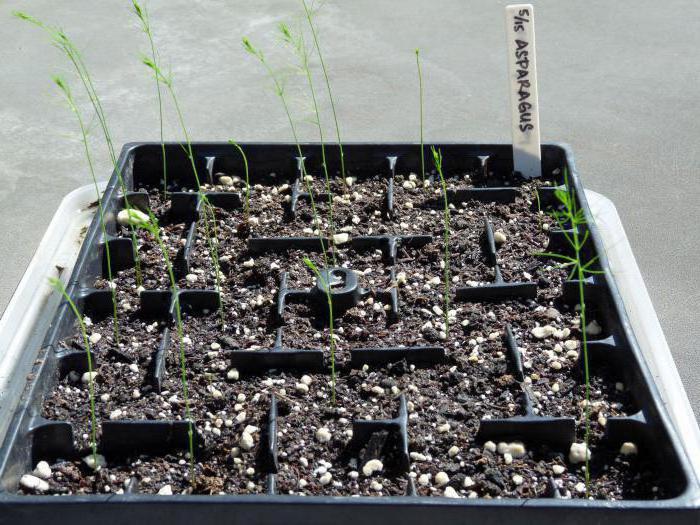
An important point in the growth of this plant is the timely harvesting of the fruits, preventing them from falling onto the soil. In the fall, there is little work to take care of it, you should remove the yellow leaves as they appear and mulch the soil with tree bark and leaves before the first frosts to keep the roots.
The spring concern for this vegetable is to fertilize with complex fertilizers and create an earthen rampart above the garden bed. Sown asparagus, the technology of growing which from seeds is not very difficult, will give the first crop after 3 years. So that it is guaranteed high, it is better to take care of seedlings in advance.
Greenhouse sowing
If you worry ahead of time that grown seedlings are ready for planting in the ground, there is a better chance that asparagus will take root better. Growing it in a greenhouse is a great option to get a strong viable shoot.
Seeds are prepared in the same way as for sowing in open ground. After they swell (3-5 days) and germinate, they are sown in separate pots or cassettes for seedlings. The best time for this is the end of March - the beginning of April. This method can significantly save time for the sprouts to strengthen before transplantation.
Soil in pots should consist of a mixture of land (2 parts) and manure, sand and peat in 1 part, respectively. Seedling care involves regular watering, loosening the soil and gradual hardening. For those 60–70 days that a plant needs to be ready for open ground, you can feed it 2-3 times with slurry at the rate of 1/6 or urea in a proportion of 20 g per 10 liters of water. Although asparagus tolerates winter frosts down to –30 degrees, it can die in spring thaws at minus five. Therefore, on warm sunny days, experienced gardeners are advised to open seedlings.
Strengthened sprouts can be planted in late May - early June, although there are those who prefer to grow them in a greenhouse for a year and only in the next spring transplant them in open ground. Similar cultivation of asparagus in a greenhouse allows many times to increase the yield.
Sowing seeds in the ground or growing seedlings in a greenhouse is not the only way to provide yourself with a useful vegetable for the long term.
Propagation of Asparagus by Rhizome
For many summer residents, asparagus planted on a personal plot has become a kind of hobby. Growing (the photo shows this) a plant that begins to bear fruit only after 2-3 years requires not only patience, but also exact adherence to technology.
The most popular and fastest for propagating asparagus is the division of rhizomes. To do this, several pieces with a living kidney are cut from the grayish-brown roots purchased on the market. This gives almost 100% survival to the plant, the main thing is that the source material itself is of high quality. Before planting, it is necessary to dig parallel trenches 40-50 cm wide and the same depth.
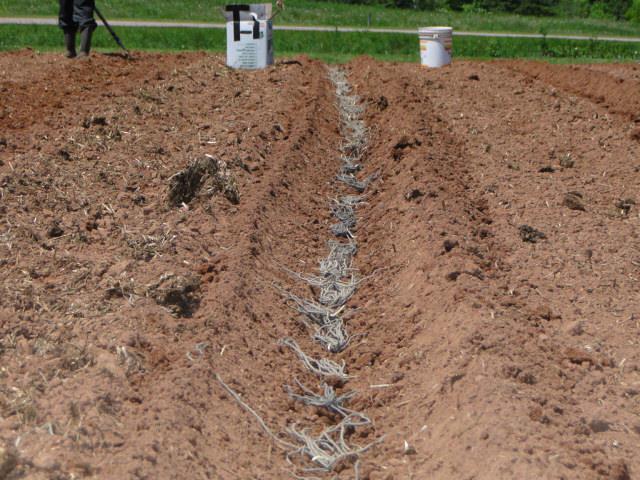
Each piece is planted on prepared and fertilized earthen mounds 20–25 cm high and 30–40 cm apart. The buds will give new sprouts, and next year it will be possible to harvest the first crop.
The best planting material is considered to be strong and healthy asparagus roots 3-5 years old, which can be planted both in autumn and spring. Since it grows and bears fruit from 10 to 20 years, you should take care of the site in advance for it. This is especially true for those gardeners who plan to grow asparagus in the country on a small amount of land.
Site preparation and care
When choosing a place for planting, you should immediately consider that this plant loves the sun and is afraid of drafts. Asparagus can be given a place on the south side along the fence, although it will also grow in the shade, only the crop will have to be harvested 2 weeks later.
This plant is unpretentious in care, giving ever higher yields as it grows, and loves fertilized and fertile soil. The ideal option is a raised bed of sandy loam soil on the sunny side of the site.
Growing asparagus in the country requires the gardener only three regular actions - loosening, watering and weeding. In the first year of its growth, it is extremely sensitive to weeds, since it can not compete with them in growth rate.Also, it does not tolerate stagnation of moisture, so the soil should dry well after watering.
With the first spring cultivation and after harvesting, it is recommended to apply mineral and organic fertilizers. The conditions for growing asparagus in cold areas with harsh winters require soil mulching, for which peat, foliage or tree bark can be used.
If there was a dry summer, it should be remembered that with a lack of moisture, this vegetable acquires a bitter taste. Watering should be frequent, but water stagnation must not be allowed, otherwise the root system will begin to rot, and excess moisture will become a place for propagation of fungi and mold.
As the plants grow, they are spudded in the spring to protect the delicate shoots from the sun, and in the fall to protect it from frost. For example, near biennial asparagus, it is recommended to raise the ground 30-40 cm, and in subsequent years - up to 50 cm.
There is also a need to cut an adult plant in the fall, leaving the stem up to 10 cm long. It gratefully responds next year with a good crop, and it is easier to cover shortened asparagus with a 10-centimeter layer of peat for the winter. In winter, it will protect from frost, and in the spring it will be a wonderful fertilizer, dissolved in thawed snow.
Asparagus Varieties
Asparagus attracted the attention of modern breeders. Growing this vegetable at home has become very popular, so there are hybrid species consisting exclusively of male plants. But traditional varieties are also popular among summer residents:
- Argentine asparagus. Growing this species is preferable because of its early maturation. This plant grows 1.5–2 meters in height, has a powerful root, giving 40-50 buds, from which by the beginning of May succulent shoots grow up to 2 cm in thickness. High productivity (up to 2 kg from 1 m2) makes it very popular among gardeners. Harvest must be done on time, as this species grows up to 3 cm per day and quickly loses moisture. It is recommended to immediately fold the collected shoots in plastic bags so that juicy asparagus is better preserved.
- Home-grown Tsarsky is also very popular. Its distinctive qualities are tasty white pulp and high productivity - up to 3 kg from 1 m2. The most tender shoots are good both boiled and fried.
- Depending on soil quality, Connovers Colossal is popular in sandy areas and Giant mammoth asparagus in heavy areas. Growing and caring for them does not require additional effort, except for fertilizing. Otherwise, caring for these varieties is the same as caring for the rest. Both species are distinguished by large shoots with excellent taste.
- Hybrid species, such as Franklin, are represented only by male plants that give a high early crop with thick “fleshy” shoots. They are suitable not only for cooking, but also for freezing, in which all nutrients are stored as much as possible.
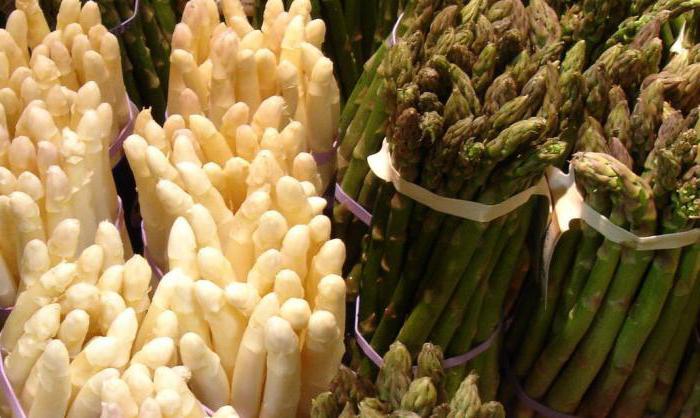
Almost all breeding varieties are represented by male plants with high productivity. If you choose asparagus cultivation as a business, it is recommended to plant them, but with different ripening dates. Each harvest takes from 6 to 8 weeks, so you can make the delivery of this vegetable to the market without interruption.
When dealing with hybrid varieties, it should be remembered that they reproduce exclusively by dividing the rhizome, not like Argentine asparagus. The cultivation of non-breeding species from the seeds of plants requires the use of greenhouses to increase the yield. But, regardless of the variety, both of them yield a crop already in the second year.
Diseases and Pests
Although asparagus, the cultivation of which has become popular among summer residents, the plant is unpretentious, but it can also become a disease, often the plant is invaded by pests.
For example, asparagus rattle larvae that feed on a plant can destroy an entire plantation if they are not sprayed with karbofos or similar means in time.
Of the diseases, the most common is rust - a fungus that affects its stems. It all starts with a few small red spots on the leaves, and by the end of the summer all the leaves will turn yellow from infection. Even if the plant does not die, the yield and quality of the product will decrease significantly. You can get rid of this fungus or prevent it by diligence and hard work. It is enough to raise the ridges, loosen the soil and make sure that the water does not stagnate.
Another unpleasant disease is root rot, due to which the neck of the plant acquires a purple color. To avoid it, it is recommended to change the place of the bed every 5-7 years and be careful when planting. If the root has been damaged, then there is a threat of disease. After replanting healthy plants, it is recommended to spray them with 1% Bordeaux fluid, and produce infected soil.
Known to many gardeners, an asparagus fly lays eggs in this vegetable, which can destroy the entire crop. The larva loves the juicy pulp of asparagus and gnaws the tunnels from the moves in the shoot. The only way to get rid of them is to dig and burn damaged plants. As a prophylaxis, deep digging of aisles in the fall helps well.
Another asparagus lover is the slugs that young shoots prefer. To prevent their appearance, special granules should be poured in advance around the site.
Harvesting and storage
Many entrepreneurs are beginning to realize that industrial cultivation of asparagus is a profitable business. It does not make a profit right away, since the harvest has to wait 2-3 years, but if you follow the technology of planting and caring for this vegetable, it will bear fruit for 15-20 years.
Asparagus is in great demand in the restaurant business and among manufacturers of healthy food, so its cost is quite high per kilogram. In addition to selling fresh shoots, the collection of which lasts only 2 months - from May to the end of June, you can earn in another way - freeze and preserve them, selling finished products afterwards.
This plant is quite unpretentious, but you need to harvest correctly, otherwise the next year you can be left with nothing.
- Firstly, you should not miss the beginning of the harvest. The vegetable himself will notify about it. When the earth begins to crack and rise in the garden, it means that it has matured. So that the shoots remain light and do not turn green, in late April - early May, you need to plant the plant. If there is no time for this, then it is enough to cover it with a black film on sunny days. This will not only “whiten” the vegetable, but also accelerate its ripening.
- Secondly, the length of the shoot ready for cutting should be 15–20 cm with a diameter of 1 to 3 cm.
- Thirdly, it is necessary to carefully dig and cut the stems with a special knife or break them off, after which the root is again covered with earth.
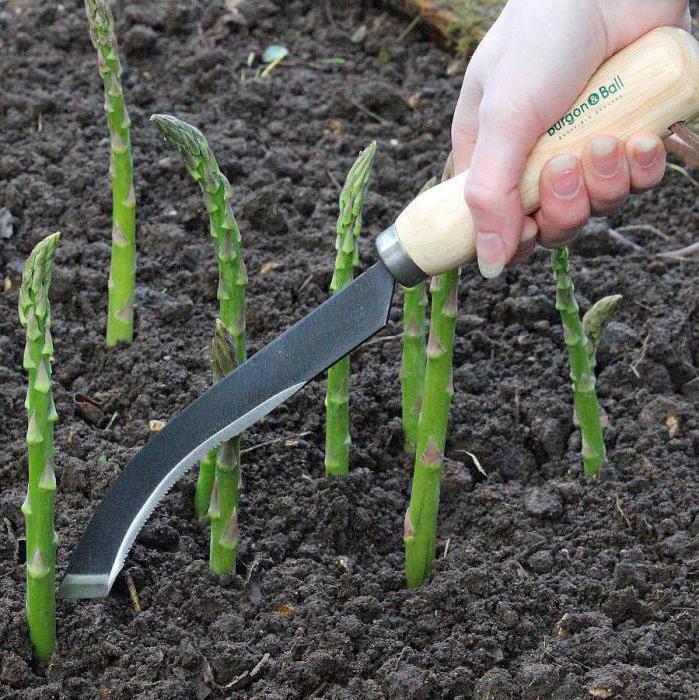
Asparagus shoots in well-fertilized soil and with regular watering grow from 3 cm per day, so the crop is removed on average every 2 days, if it is cloudy, and daily, if it is sunny. Much depends on the climate. For example, in the southern regions, asparagus is cut twice a day. Growing in the suburbs, where the climate is cooler, makes it possible to harvest every day. In areas with a short cool summer, shoots ripen more slowly, so even 2-3 days can elapse between cuts.
It is important to remember that asparagus loses its healing and vitamin properties within a few hours, so its use or marketing must be established. This vegetable is well stored, preserving all its nutritional qualities in frozen or canned form. As he begins to enjoy increasing demand, it will be easy to find customers for this product.
Permaculture System
In the 21st century, a new direction appeared in the farming system - permoculture, the basis of which is “communities” of plants grown in a single space. At the same time, one particular crop is not preferred, as is customary, but there is a combination of garden, garden and meadow plants throughout the site.
The main conditions for conducting such agriculture are a large area of land, not less than a hectare, and climate change within it. So, in the southern regions it should be made wetter, for which they create a stepped system of artificial ponds. Vapors of water give the necessary level of moisture, and also these reservoirs are used for watering and breeding fish.
So that the banks of the ponds do not erode, a mixture of grain and leguminous plants is planted on them. At some distance from them, you can plant fruit trees and shrubs that protect the site from the winds and create an additional shadow.
In the northern regions, it is necessary to increase the air temperature, for which stones of different sizes are laid along the perimeter and along the site itself. They cover plants from cold winds, and heated by the sun, give them their heat.
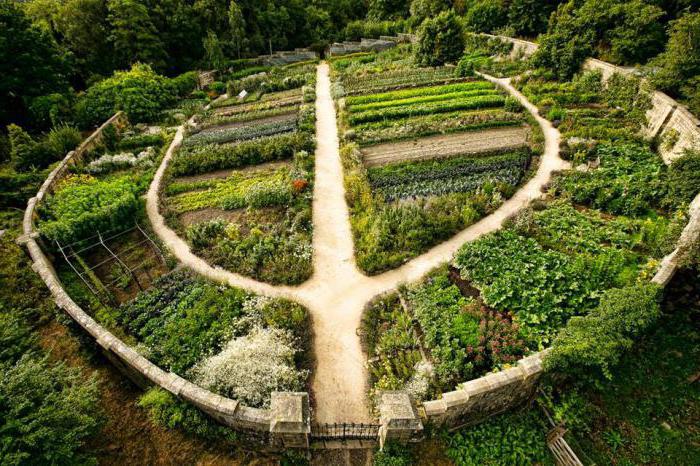
Sowing on the prepared land is carried out in April, for which seed plants are planted on the ridges - beans, corn, peas, pumpkin, sunflower, watermelons, asparagus. Growing from seeds (permaculture involves a step planting) is on one tier, on the other you can plant potatoes, carrots, tomatoes and other vegetables.
Such a multi-tier planting allows you to collect large crops in due time on each of the ridges. This innovation is especially interesting for those who prefer to spend their time on many crops - from medicinal herbs and vegetables to cereals, berries and fruits.
The seedless way to grow asparagus
For gardeners who do not have a large margin of time, the most "lazy" is suitable - a natural way of planting this vegetable. It turns out that if you collect and bury asparagus fruits in the selected and prepared section in the fall, they will sprout themselves perfectly. In this case, the summer resident will be usually weeding, loosening the soil and watering.

Asparagus planted in this way yields a crop already in the second year, if the region is southern. Additional fertilizers are desirable, especially if the soil is poor or depleted. The natural method, as the example of some summer residents shows, allows each autumn to collect asparagus fruits and sow new plots with them. Considering that this vegetable is not only useful, but also expensive, it is beneficial to do it both for profit and for own consumption and economy.








